|
Primal Cuts | Roasts | Hams | Chops | Steaks | Ribs | Tenderloin
Miscellaneous | Sausage | Variety Meats
There are numerous pork products available, consisting of fresh, frozen, cured, smoked, uncooked, fully cooked, and many heat-n-serve products. Some products are available breaded, seasoned or marinated. The products range in size from whole primal cuts down to cubes and strips of pork. Listed below are some of the many pork products that are available.
| Whole Primal Cuts |
| The primal cuts can be purchased whole and then cooked whole or they can be cut down into sub-primal and retail cuts. Purchasing a whole primal cut will be more economical, but if you are not knowledgeable on how to cut the primal cut into smaller cuts, it may result in too much waste and incorrect cuts. The primal cuts most often ordered whole are the loin and the leg/ham. If a whole primal cut is desired, you will generally need to order it in advance. They are available fresh, cured, smoked, bone-in, boneless, and fully cooked. |
|
Pork Roasts
Generally a larger cut that is used to serve several people. Roasts can range in size from as small as 2 lbs. up to 20 lbs. or more. They are available from almost all the primal cuts and vary in tenderness and leanness, depending on the cut they are taken from. Most are available bone-in or boneless and some are available cured, smoked and fully cooked, but generally they are purchased fresh. |
|
Blade Boston Roast
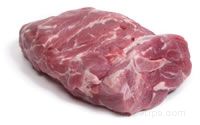
|
Sometimes called Boston butt roast, this roast is from the shoulder primal cut. The roast is tender and it contains a fair amount of fat which keeps the meat moist and provides good flavor to the meat when it is cooked. |
|
Shoulder Blade Roast
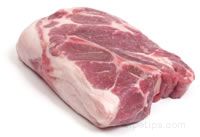
|
A roast from the shoulder primal cut, which is fairly tender and flavorful. This roast is cut from the section of the shoulder closest to the blade end of the loin. It is marbled with a fair amount of fat which keeps the meat moist and provides good flavor to the meat when cooked. |
|
Boneless Shoulder Roll
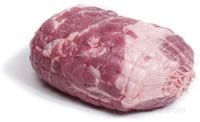
|
A boneless shoulder roll is a roast from the blade shoulder. The bones are removed and the meat is rolled and place in a string type bag, which remains on the roast as it is cooked to hold the shape of the roll. The boneless shoulder roll is available fresh, or cured and smoked. |
|
Picnic Roast
|
Sometimes called arm roast, this roast is a fresh cut that comes from the shoulder primal cut and it contains more fat than the blade Boston roast. A well trimmed roast provides a very rich flavor when roasted. Often this cut is smoked and then it is referred to as a picnic ham, although it is not a true ham. This cut is economically priced. |
|
Blade Loin Roast

Bone In

Boneless
|
Sometimes called rib end roast, this roast is cut from the end of the loin closest to the shoulder. It is leaner than the shoulder roasts but contains more fat than the other roasts cut from the center cut or sirloin end of the loin. It is available bone in and boneless. |
|
Crown Roast
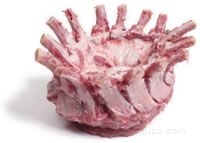
|
The crown roast is an elegant roast made from two center cut racks of ribs, which are bent to form a circle and then tied together with the bones facing out. The two racks are tied together with string to hold their shape and then the bones are frenched at the top so that at least one inch of bone is exposed. This roast generally must be special ordered and is priced higher than other roasts. |
|
Center Cut Loin Roast
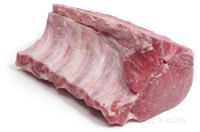
Bone In
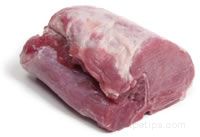
Boneless
|
A lean and tender fresh roast taken from the middle of the loin primal cut. It is considered one of the prime cuts of pork. It contains part of the backbone, which adds flavor but makes it harder to carve. The bones are sometimes frenched on this roast to make it easier to slice after cooking. When this is done it is called a rack of pork. This roast is frequently boned to make it easier to carve when cooked. The bones are sometimes tied to the roast to add flavor while cooking and they are then removed to carve. The rack of pork and the boneless roast will generally cost more and need to be special ordered. |
|
Rack of Pork
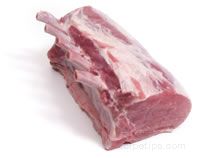
|
A rack of pork is a center cut loin roast that has had the bones frenched, which makes it easier to cut after it is cooked. You can french the roast yourself or you can have it special ordered already frenched. A special ordered frenched roast will generally cost more than an unfrenched roast. |
|
Sirloin Roast
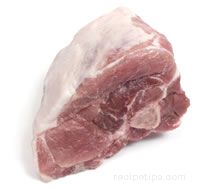
|
A roast cut from the sirloin end of the loin, which is the end closest to the hind leg. It is a fairly lean roast but contains part of the backbone and hipbone, which makes it harder to carve. Economically priced. |
|
Fresh Ham Roast
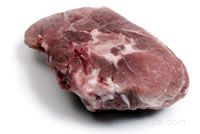
|
A roast, cut from the leg/ham primal cut, which has not been cured or smoked. It is lean and flavorful but because of its location on the pig, the ham roast is generally not as tender as the other cuts and its bone structure makes it more difficult to carve. A cut from the top of the leg is sometimes called a top leg roast or an inside roast and a roast from the bottom portion is called a shank roast or leg roast. |
|
Hams
Hams are cuts of pork that come from the leg, which have been dry-cured and smoked (country hams) or wet-cured and then boiled or smoked (city hams). The dry-cured hams are saltier, stronger flavored and have a coarser texture. Hams are larger cuts used to serve several people. A whole ham can weigh 10 lbs. to 20 lbs. or more, but are generally sold in halves. They are fairly low in fat but high in sodium and are available bone-in, semi-boneless or boneless. There are many different varieties that are cured and smoked using different methods and some are processed to have a lower fat content.
Some of the terms used to describe the different ways in which hams are processed are shown below. The terms will help to explain the types of ham available and the preparation required.
Bone-in Ham - This type of ham can be a butt or shank portion or it could be a whole or half leg that has the hip, thigh and/or shank bone remaining as part of the ham.
Semi-Boneless Ham - A ham from the leg primal cut that has only the leg bone remaining. The hip or shank bone has been removed, making it easier to carve.
Boneless Ham - A round, oblong or rectangle-shaped cut that has all of the bones and most of the fat removed.
Fully Cooked Ham - A ham that has been heated through to the middle reaching temperatures exceeding 147°F making it ready to eat without further cooking.
Partially Cooked Ham - A ham that has been heated through to the middle reaching temperatures exceeding 137°F, but still requires additional cooking prior to eating.
Uncooked Ham - A ham that requires cooking to prepare the meat for eating.
Boiled Ham - A ham that has been boned, cured and cooked using a process that includes boiling the ham in water. It is ready to serve as sliced ham or ham pieces.
Shown in the chart below are some of the different types of hams that are available. When selecting a ham it will generally have a description on the label that includes one or more of the terms from above. |
|
Whole Ham
 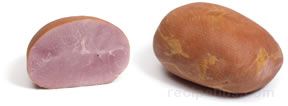
|
| A processed cut which includes both the butt ham and shank ham from the leg. Whole hams can weigh from 10 lbs. to 20 lbs. or more. They are available bone-in and boneless. |
|
Butt Ham
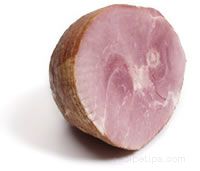 
|
| A processed cut taken from the top half of the leg. It is fattier than the bottom half but contains more meat and is easy to carve around the bone. It is generally more expensive than the shank ham. |
|
Shank Ham
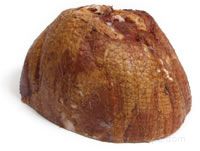 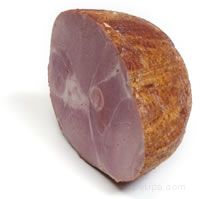
|
| A processed cut taken from the bottom half of the leg. It contains less fat, is not as meaty as the butt ham, and is also harder to carve. It has a slightly sweeter flavor. |
|
Spiral Sliced Ham
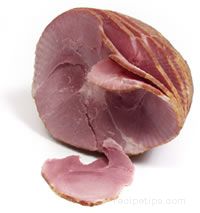
|
A precooked ham that has been presliced in a spiral cut for your convenience. A spiral cut is a cut that is done in one continuous cut around the ham, starting at one end, and moving consistently to the opposite end to create the same thickness of slices throughout. |
|
Canned Ham

|
Ham that has been cured, with the bones removed and then vacuum-sealed in a can with a small amount of dry gelatin. The ham is steam cooked in the can and the gelatin helps to absorb the natural juices of the ham. When opened, it is ready to eat or it can be heated before serving. Canned hams are not as flavorful and have a different texture than other ham but they offer convenience. Check the can for refrigeration instructions because some require refrigeration before opening and some only require it after opening. |
|
Picnic Ham

|
This is not a true ham but a cut from the shoulder of the pig, which has been cured and smoked. It is not as lean or tender but is less expensive. A good choice when in need of chopped or diced ham to add to other dishes. |
|
Prosciutto Ham
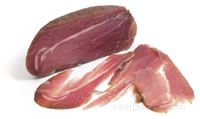
|
A dry cured ham, originating in Italy and made from the meat of the pork butt section. It has a firm, dense texture and a delicate flavor. It has a rosy brownish rich color and is available as a bone-in ham, as a boneless ham, or as paper-thin slices. Since it has been cured it can be served raw. When served raw it is referred to as "prosciutto crudo" and often used as an appetizer. It can also be cooked, which it is then referred to as "prosciutto cotto". When cooked, it becomes an excellent deli sandwich meat. |
| Gourmet Ham |
A ham that is cured, smoked and then allowed to age for a longer period of time (1 year or more) than other hams. The additional aging develops more flavor in the ham. |
| Specialty Ham |
A hams that has undergone special processes for curing and cooking to produce a distinctive flavor. The flavor and curing processes vary depending on the ham. |
|
Center Ham Slice
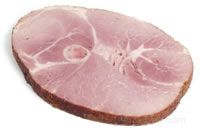
|
Also referred to as center cut ham steak, this cut is approximately ½ to 1 inch thick and is sliced from the center of the leg primal cut. It is available as a fresh cut of meat or it can be cured and smoked. The ham center slice may be found boneless or with a small circular bone included. It is also available fully cooked and ready to serve. |
|
Pork Chops
Chops are smaller cuts from the loin primal cut. They are individual serving cuts that are sliced to various thicknesses. Depending in the size of the chop, 1 or 2 chops may be served as a single serving. Single chops may vary from ½" to 1 ½" thick and double rib chops may be as thick as 2 inches. The thickness chosen will depend on how they will be prepared and the appetites to be satisfied. They are available fresh, smoked and bone-in or boneless, varying in quality and composition according to their location on the loin. At times they can be found precooked, ready to heat and serve, and also pre-stuffed. |
|
Blade Chops
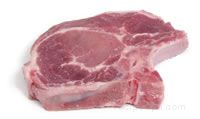
|
Chops that are cut from the shoulder end of the loin. They are very juicy and flavorful but contain more fat, gristle and bone than the other chops and have a tendency to be tough. |
|
Rib Chops

|
The rib chops are located next to the blade chops at the rib end of the loin. They contain some fat but are tender, juicy and very flavorful. The rib chop, the loin chop and the center cut chop are the most preferred and the most expensive chops. |
|
Loin Chops
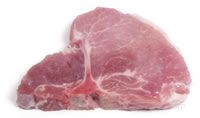
|
They are located in the middle of the loin as part of the center cut subprimal with part of the tenderloin included with it. When the tenderloin section is not included with this chop it is called a center cut chop (sometimes called top loin chops). The loin chop and the center cut chop are very tender and contain little fat but are not quite as flavorful and juicy as the rib chops. The chops have a t-shaped bone similar to a t-bone steak. Loin chops, center cut chops, and rib chops are the more popular chops. |
|
Sirloin Chops
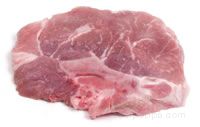
|
Chops that are cut from the sirloin end of the loin, which is the end closest to the leg. The sirloin chop is a lean cut that contains part of the tenderloin but it is not very flavorful. It also contains more bone than the other chops and has a tendency to be dry. It is one of the least preferred and least expensive of all the chops. |
|
Butterfly Chops
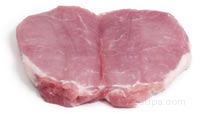
|
A double chop, generally cut from a boneless loin, which has been cut through the middle from one side to the other side, stopping short of cutting all the way through. The chop is then opened up and laid out flat, forming a butterfly shape. It provides a very appealing cut for those special occasions. |
|
Boneless Chops

|
Rib and loin chops are available in boneless cuts and in various thicknesses. The boneless cuts provide convenience in preparation and eating, but are generally slightly more expensive that the bone in cuts. |
|
Pork Steaks
Steaks are individual cuts that are generally sliced from cuts that are used as roasts. They are most often sliced from roasts such as blade Boston roast, center loin roast, sirloin roast, and the fresh ham roast. They will vary in leanness and flavor depending on the section from which they are cut. Some of the pork steaks are available pre-seasoned. |
|
Pork Blade Steaks
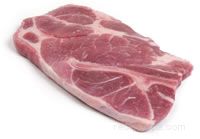
|
The blade steaks are cut from the blade Boston roast or the shoulder blade roast. Like the roasts, the steaks are flavorful and contain significant amount of fat to keep them moist while cooking. Because the blade steak is cut from an active muscle location on the pig, it will be less tender. Also referred to as pork steak. |
|
Arm Steaks
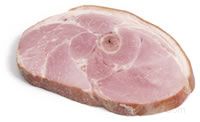
|
The arm steaks are sliced from the picnic (arm) roast. They are rich in flavor but contain more fat than the pork blade steaks. Like the blade steak, the arm steak is cut from an active muscle location on the pig, which results in a cut that is less tender. The arm steak is available smoked or fresh. |
|
Fresh Ham Steaks

|
The fresh ham steaks are cut from the middle of the leg primal cut. They are flavorful and fairly lean but are generally tough due to their location in an active muscle of the pig. |
|
Pork Ribs
The ribs are cuts taken from the loin and the side/belly primal cuts. There are several different types of ribs and they vary in meatiness and bone structure depending on the section from which they are cut. The number of people the ribs will serve varies according to the type of rib. Ribs are available fresh, smoked and fully cooked. They are also found pre-seasoned and with sauce that is pre-applied. Some products only need to be heated and they are ready to serve. |
|
Back Ribs

|
| Ribs taken from the center cut and part of the blade end of the pork loin. They consist of a minimum of 8 ribs but can include up to 14 ribs. An average rack of ribs includes 12 to 13 ribs. The ribs have meat between the bones and are meatier than spareribs, but do not have as much meat as country-style ribs. |
|
Country-Style Ribs

|
Ribs taken from the blade end of the loin closest to the shoulder. Country-style ribs are meatier than other ribs but they are not as easy to eat, due to their bone structure and fat running through the meat. They include a minimum of 3 ribs and can be as many as 6 with bones or boneless. |
|
Button Ribs

|
Flat circular shaped bones located at the sirloin end of the loin. The button ribs consist of the last 4 to 6 bones on the backbone that do not have actual ribs connected to them. The meat on the button ribs consists of meat that covers each rib and connects them together. |
|
Spareribs

|
The intact rib section, including the brisket bone, taken from the side/belly. The rib section may also include the costal cartilage. Spareribs contain more bone than meat and also quite a bit of fat. Both the bones and the fat contribute to making the ribs tender and flavorful. |
|
St. Louis Style Ribs

|
| Spareribs with the brisket bone removed. The brisket bone is removed parallel to the rib side (perpendicular to the direction of the rib bones), resulting in exposure of cartilage on the brisket bone. The skirt meat (extra meat along the bottom edge on the bone side of the ribs) may be left on or removed. |
|
Kansas City Style
(or Bar-B-Q Cut) Ribs

|
Similar to the St. Louis style ribs except they are trimmed more, making the ribs less meaty. The end flap and hard bone along the bottom are trimmed and the ribs are cut into a rectangle shape, resulting in a cut resembling back ribs. |
|
Riblets

Boneless
|
Smaller rib portions created when the back ribs or spare ribs are cut down to straighten or to make smaller. The riblet portions will vary in size and are also available boneless. |
|
Rib Tips
|
The brisket bone that is trimmed off the spareribs when producing St. Louis Style ribs. Rib tips are small meaty pieces of the breastbone. |
|
Pork Tenderloin
The tenderloin is the leanest and most tender cut of pork. It is located along the bottom of the loin, starting in the center cut and running back through the sirloin end. Because of its leanness, care should be taken so that it is not overcooked. It is available whole or cut into scallops and medallions. It is also available marinated and seasoned with flavors such as garlic and onion, lemon garlic, herb, peppercorn, mesquite, honey mustard, and teriyaki. The tenderloin is generally a fairly expensive cut. |
|
Whole Tenderloins

|
Whole tenderloins are frequently sold in pairs. |
|
Medallions
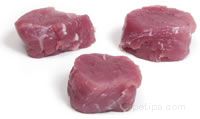
|
Medallions are thick slices of tenderloin. The tenderloin is cut across the grain to form slices that are approximately 1 to 1 ½ inches thick and weigh between 3 and 6 ounces. The slices are then molded into a round uniform shape. Medallions can be purchased pre-sliced or a whole tenderloin can be purchased and sliced into medallions. |
|
| Miscellaneous Products |
|
Pork Cutlets
(Scallops):
|
Cutlets are thin boneless pieces of meat that weigh 4 ounces or less and are taken from tender cuts, such as the tenderloin and loin. They have most of the fat trimmed off and are generally pounded to ensure uniform thickness and to thin them out so that they will cook evenly and quickly. |
|
Pork Patties:

|
Pork patties are made from boneless meat or ground meat that has been formed into a round, oval, or chop-like shape. They are generally fully cooked and some have been breaded or coated with sauce. |
|
Ham Patty
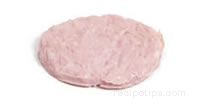
|
Coarsely ground ham or chunks of ham that have been pressed and formed into a round, flattened patty, which are generally prepared by baking, grilling, broiling or frying. They are available packaged as a canned product and as a frozen product. |
|
Canned Ham Chunks
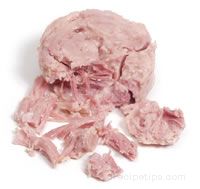
|
Chunks of ham that have been precooked and packaged in a can. The cans are tightly sealed to preserve freshness of the meat and the meat generally does not need refrigeration until the can has been opened. The canned ham can be used in recipes that call for chunks of ham. |
|
Deviled Ham

|
Ham meat or a mixture of ham and pork shoulder meat that is cured and then cooked with water, spices and other ingredients. The meat in some deviled ham is also smoked. After the meat and other ingredients are cooked, they are finely chopped into a minced meat and packaged in a can and sealed. The spread generally is mixed with a combination of other ingredients, such as sour cream, cream cheese, mayonnaise, mustard, cheese, chopped vegetables, and spices. The spread mixture is used for sandwiches, as an appetizers to spread on crackers, or as a meat dip. |
|
Pork Shanks (Hocks)

|
The shank is the lower section of the front or hind leg. It is most often cut from the front leg, which contains a lot of bone, but adds much flavor to soups and stock. Shanks are sometimes available smoked. |
|
Canadian Bacon
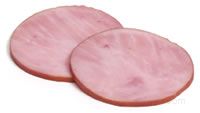
|
Canadian bacon is a fully cooked and smoked cut that is taken from the loin. It is much leaner than bacon from the side/belly with a texture and flavor closer to ham. It is a popular breakfast meat but is also used as an entrée, on pizza and for sandwiches. |
|
Cottage Bacon
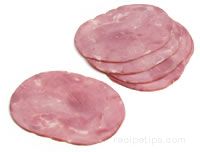
|
Cottage bacon is made from the leaner pork meat in the shoulder cut. It is generally shaped, cured, and then sliced into round pieces for baking or frying. This form of bacon is similar to a slice of ham and can be served for breakfast or as a luncheon meat for sandwiches. |
|
Bacon

|
Bacon is taken from the portion of the side/belly that is left after the spareribs are cut away. Bacon is cured, and generally smoked, and then sliced, into thin or thick strips. It is also available in unsliced slabs. The strips generally contain more fat than lean, which when cooked most of the fat melts off, leaving the bacon strip with a delicious flavor. It is generally sold by the pound and can also be found precooked, ready to heat and serve. Other varieties that may be found are maple and honey flavored, sugar free, low fat, and low salt. |
|
Precooked Bacon

|
Precooked bacon is fully cooked and packaged. It only requires heating in the microwave before serving, providing convenience in preparation. |
|
Bacon Bits
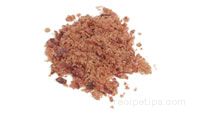

|
Pieces of crumbled bacon, which are fully cooked and ready to use. The bacon pieces are available crumbled in fine bits (bacon bits) and also in a little larger pieces (bacon pieces). They are used as a garnish for or an ingredient in salads, dressings, potatoes, omelets, quiches, soups, pizza, dips, snacks, and spreads. |
|
Salt Pork

|
Salt pork is taken from the same portion of the pig as bacon, with only the fattier areas used. It is salt cured but is not smoked. It is generally blanched to remove the excess salt before it is used. Salt pork is basically used to add flavor to other foods. |
|
Ground Pork

|
The meat from the shoulder of the pig is minced or ground to produce ground pork. It can be prepared in the same manner that ground beef is prepared. Ground pork is sold in bulk by the pound and can also be found formed into round or oval patties. |
|
Cubes and Strips
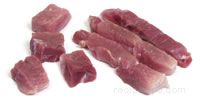
|
Cubes and strips are cut from all of the primal cuts except the side/belly. Cubes may vary in size, with larger cubes used for kabobs and slightly smaller ones as stew meat or in other dishes. Pork strips are used in stir-fries, salads and sandwiches. The cubes and strips are generally sold by the pound. |
|
Stew Meat

|
Stew meat is similar to cubes of pork, only they are smaller in size and are generally cut from the tougher cuts of meat. They benefit from slow moist cooking. |
|
Pork Frankfurters (Wieners)

|
Frankfurters are processed from the combination of pork trimmings, seasonings and curing ingredients. The trimmings are ground and then the other ingredients are added. They are available in fine or coarse ground varieties. The mixture is stuffed into a casing and then cured, smoked, cooked, and cooled. Once cooled, the casings are generally removed and the franks are vacuum-sealed in packages. They are also available with the casings left on and can be found made from pork, beef, turkey, chicken, or a mixture of these meats. They can also be found with ingredients such as cheese and peppers added. |
|
Pork Rinds:
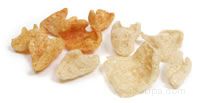
|
Pork rinds are light crunchy chips made from pork skins that are deep-fried in lard. They are high in protein and contain no carbohydrates. They are available in flavors such as BBQ and salt & vinegar. There is also a pork rind product available that is cooked in the microwave to provide a fresh warm snack. |
|
Pork Sausage
There are many different types sausage available. They are made from fresh ground pork, seasonings, fat, preservatives, and fillers, such as breadcrumbs, rice, cereal, soybean flour, and dried milk solids. Some varieties are a mixture of pork and other meats, such as beef, veal and poultry. Sausage can be found in the form of ground meat, patties, stuffed into casings and slices. The casings can be a natural casing made of animal intestines or an artificial casing. They are cured and/or smoked and may also be cooked or dried. Different varieties of sausage are served for various purposes, such as entrées, breakfast meats, luncheon meats, and appetizers. The basic types produced are shown below. |
|
Fresh (uncooked)
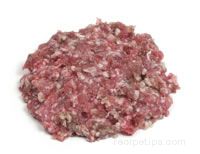 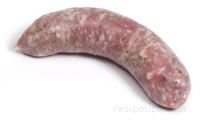
 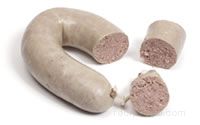
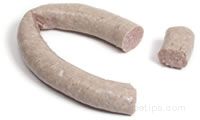
|
| Sausage made from uncooked pork, which is chopped or ground, seasoned and then sold in bulk, formed into patties or stuffed into a casing. It may also have other meats, such as beef or poultry, added to it. Fresh sausages have not been cooked or cured, but may be smoked and must be cooked before eating. Includes products such as ground sausage, bratwurst, weisswurst, bockwurst (also available cooked), and linguica. |
|
Smoked and Cooked
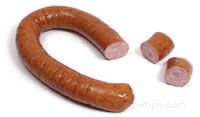 
  
|
| Made from fresh chopped or ground pork that is cured, smoked and cooked fully. These sausages are ready to eat and include products such as kielbasa (cooked polish sausage), franks, bologna (sold in rings and slices), and knackwurst (knockwurst). Some of the products, such as franks and bologna, are available as fine ground and coarse ground. |
|
Cooked
 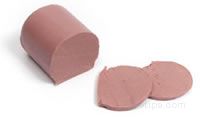
|
| Pork sausage that has been fully cooked but not smoked or cured. It is generally in the form of skin-on or skinless links and patties that are ready to heat and serve but can also be found in a processed form, such as braunschweiger, which is used as a meat for sandwiches. |
|
Dried
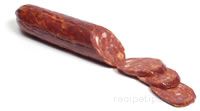 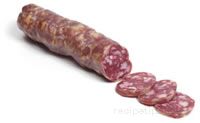
 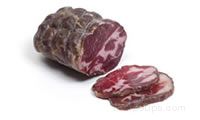
|
| Sausage that has been cured and dried under a controlled process using bacterial fermentation to create a distinctive flavor. They are wrapped in a casing and are generally hard and dry in texture and can be stored indefinitely without refrigeration as long as they are sealed in their original package. Once opened, they should be refrigerated. Pepperoni, Genoa salami, cotto salami, and chorizo are common dry sausages that are available. Dried sausages are ready to slice and serve. |
|
Semi-dry
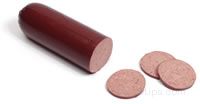 
|
| Semi-dry sausage is dried in the same manner as dry sausage but does not have as much moisture removed. They sausages are softer than the dry sausages and should be refrigerated to maintain their quality. Summer sausage, Lebanon bologna, and mortadella are examples of semi-dry sausage. |
|
Sausage Specialties
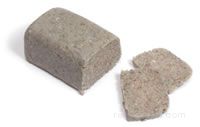 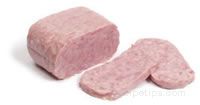
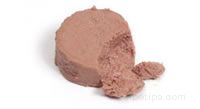 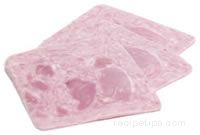
 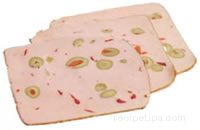
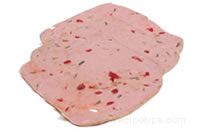 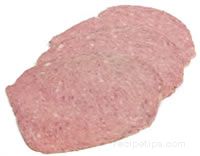
|
| These are ready to slice and serve products that consist of ground meats, which are seasoned and cooked but generally are not smoked. The sausage specialty products are most often used for making sandwiches and hors d'oeuvres. They are often referred to as luncheon meats or cold cuts and are available in loaves, canned, sliced, and as prepackaged vacuum packed slices. They require refrigeration and for maximum freshness should be used within 3 to 5 days after opening . Canned meats, chopped ham loaf, peppered loaf, honey loaf, olive loaf, and scrapple are examples of sausage specialty products. Some of the specialty meats are available in reduced fat varieties also. |
|
Variety Meats
The variety meats include the organs, glands and the extremities of the pig. The meats taken from younger pigs will be more tender and milder in flavor. Some variety meats are readily available in food stores and most are available from a butcher or specialty meat market but may require special ordering. They are very perishable, so if they are not going to be used within 24 hours of purchasing, they should be frozen immediately. |
| Liver |
Pork liver is generally available fresh or frozen. It is stronger flavored and not as tender as the liver from other animals. The liver should smell fresh, be bright colored and appears moist but not slimy. |
| Heart |
The heart is generally available fresh or frozen. It has a mild taste with a tendency to be tough because it is mostly muscle. If taken from a younger animal, it will be more tender. The heart is red in color and should smell fresh. Do not select if it has a brownish or grayish tint to it. |
| Kidneys |
The pork kidney is a single-lobed glandular organ, which is best taken from a younger animal to provide a milder taste and more tender meat. The kidneys from an older animal will have a dark reddish brown color and the younger animal's kidneys will be pale in comparison. Choose kidneys with a moist, even colored surface and firm texture. |
| Tongue |
Tongue is fairly tough and must be cooked using low heat for a long period of time to produce a tender piece of meat. This variety meat can be served hot or cold. To prepare fresh tongue for cooking it must be scrubbed and cleaned thoroughly. Tongue can be found fresh, pickled and smoked. |
| Sweetbreads |
Sweetbreads consists of two thymus glands, one located in the throat and one near the heart. The pork sweetbreads generally need to be special ordered. They should be taken from a piglet, otherwise they will have a fairly strong flavor. The sweetbreads should be firm, plump and white in color. The best sweetbreads are taken from veal or young calves. They have a very smooth texture, a mild flavor and are more readily available in specialty markets throughout the year. |
| Brains |
Brains can be found in most specialty meat markets and some well stocked food stores. Select those that are firm, plump and pinkish white in color. Brains are very high in cholesterol. |
|
Others
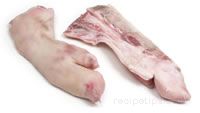
|
Other variety meats that are available include pig's feet, jowl, snout, head, and more. | |

